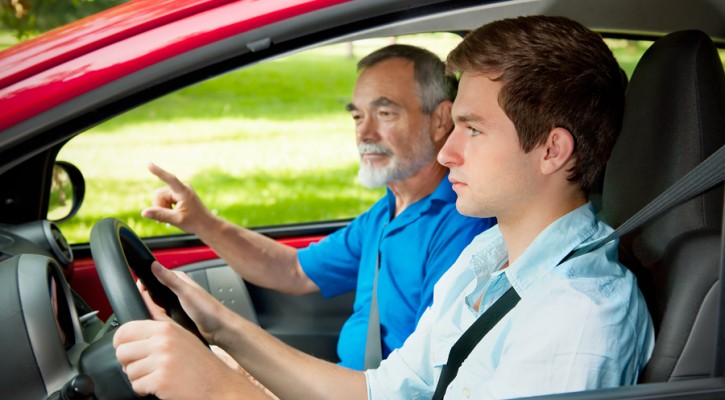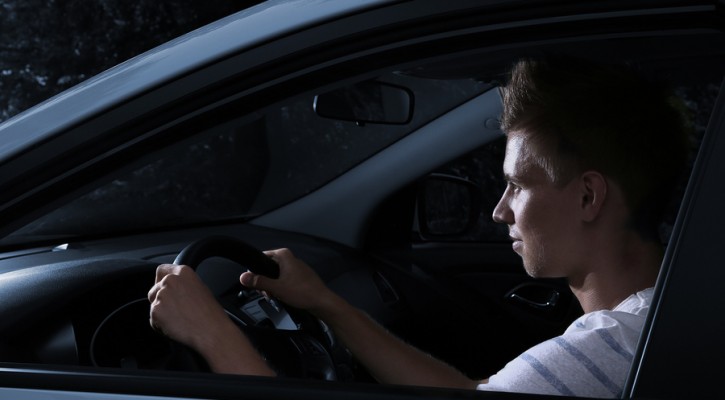Tag Archive: teen driver

How to Use a Teen Driving Checklist
April 14, 2009
Teaching their teen to drive is a stressful experience for many parents. The parent is nervous about the teen driver’s safety, while the teen is giddy with excitement. Parents may be ambivalent about this rite of passage because it means their child is growing up, while teens are eager for the new level of freedom and independence associated with a driver’s license. The parent wants the teen to absorb as much information about the driver training process as possible; the teen just wants to learn enough to pass the road test.
One way to manage driver training sessions is to use a Teen Driving Checklist. The checklist provides an opportunity to review concepts and provide feedback on the driving lesson. Using this tool provides structure to each lesson, which facilitates learning for the teen and helps the parent feel more comfortable about the process of teaching the teen to drive.
The parent should complete one copy of the checklist during each lesson. Before the parents share it with the teen at the end of the lesson, the teen can complete a second copy of the evaluation. This self-evaluation helps teens learn to assess the driving behavior of themselves and other drivers, a critical concept once they are out on the road on their own. After the teen finishes the self-assessment, the two checklists should be compared and discussed in detail.
Parents should be sure to acknowledge areas of improvement as well as make a note of skills that need further discussion and practice. If the driving lesson was particularly difficult, parents can wait a few hours to have the discussion, but it should take place prior to the next driving lesson so the teen won’t continue to practice bad habits.
Since the checklist includes basic, intermediate, and advanced skills, parents can easily tailor each driving lesson to a specific set of skills. Avoid packing too much into one driving lesson, which could overwhelm the teen driver. It is better to hold a few extra lessons than to take a chance on skimping on a teen driver’s knowledge of critical driving skills.

Safety Features That Will Lower Your Teens Auto Insurance
February 26, 2009
Many parents view the licensure of their teen driver with some trepidation, not only because of concerns for their teen’s safety but due to practical considerations such as the high cost of auto insurance for teen drivers. Luckily, one of the ways you can reduce the cost of your teen’s insurance will also keep your teen safer – selecting a vehicle equipped with certain safety features.
Your insurance company may offer discounts for the following safety features. If not, it pays to shop around. Discounts for vehicle safety features vary widely among insurance companies.
- Air Bags: Passenger and driver-side dual airbags are now required in all vehicles sold in the United States. Air bags must be used with safety belts for maximum effectiveness.
- Head Injury Protection: This feature, which lessons the blow if your head hits the interior roof of your vehicle, has become standard in recent years. If you select an older vehicle for your teen, it may not have this safety feature.
- Advanced Headrests: These systems allow the back of the seat and headrest to move down and back if the vehicle is hit from the rear, reducing the forward motion and thus decreasing the severity of head and neck injuries.
- Automatic Daytime Running Lights: This feature makes it impossible for your teen to drive without headlights, making your teen’s vehicle more visible when driving, even during daylight.
- Anti-lock Brake System: This feature eliminates the need to “pump the brakes” when you have to stop quickly, preventing the wheels from locking up and the vehicle from skidding. ABS pumps the brakes for the driver; the driver keeps constant pressure on the brake pedal and concentrates on steering. This allows the driver to regain control in bad weather conditions or quickly avoid a crash.
- Traction Control: While ABS helps drivers maintain control while braking, traction control helps them do so while accelerating. This feature stops the spinning of a wheel due to wet roads, loose gravel, or fast acceleration by braking it, reducing the fuel or cutting spark plug ignitions, depending on the type of system, which improves traction.
- Electronic Stability System: This feature coordinates the ABS, Traction Control, and the “yaw” of your vehicle (how much the vehicle rocks side to side). The system reduces tire spinning, skidding, and tractionless cornering, keeping the vehicle’s tires in maximum contact with the road.
Read more about how to lower your teens auto insurance rates through driver safety and driver education courses.

Five Worst Teen Driving Mistakes: Part Four
January 12, 2009
Most parents live in dread of the day their teens get a driver’s license and get behind the wheel alone. Their concerns are well-founded, since teen drivers have the highest death rates in car crashes of any age group. Motor vehicle crashes are the number one cause of death among Americans aged 15-20. But parents can help their teens be a safer driver even after they are licensed, particularly by paying attention to common risk factors.
In this five-part series, we’ll discuss the five worst teen driving mistakes:
- They don’t wear safety belts.
- They drink and drive.
- They panic/overcorrect in emergency situations.
- They drive too fast for conditions.
- They ride with other teens.
In this, part four of the series, we’ll discuss a frequent cause of collisions for teen drivers – driving too fast for conditions. In addition to succumbing to the lure of speeding on a straight, dry road, teens often fail to lower their speeds on hazardous roads or in dangerous weather conditions. They may compensate for heavy traffic by weaving in and out of traffic and braking more frequently instead of simply reducing speed.
Higher speeds reduce maneuverability, increase stopping distances, and decrease reaction time. Problems caused by increased speed are often magnified in adverse conditions, such as poor visibility or on wet or snowy roads. Teach your teen to be prepared to adjust speed for varying conditions and situations. Different traffic, roadway, and weather conditions can change the amount of time and space needed for slowing down while maintaining control of the vehicle.
Be sure to let your teen practice driving with you in the passenger seat in a variety of road and weather conditions, even after your teen has a driver’s license. Ask your teen to identify the roadway surfaces and conditions at the beginning of each lesson. If the weather changes while you are driving, be sure your teen responds appropriately. For example, if it is sunny when you start out but begins raining during your drive, make sure your teen reduces speed to accommodate the slippery road surface.
Make sure your teen maintains an appropriate following distance at all times. Check your driver handbook for the recommended following distance in your state. Teach your teen to add seconds to the minimum following distance for poor road conditions, bad weather, poor visibility such as in darkness or fog, or in any area where additional hazards are present.
Review the following points about speed with your teen:
- Speeding reduces a driver’s ability to steer safely around curves on the highway or avoid objects in the roadway.
- Speeding extends the distance necessary to stop the vehicle, increases the distance a vehicle travels while a driver reacts, and reduces the effectiveness of the vehicle’s safety features.
- The faster the vehicle is traveling, the greater the impact if the vehicle does crash. Inversely, the effectiveness of restraint devices like airbags and safety belts and vehicular construction features such as crumple zones and side member beams decline as impact speed increases.
- The probability of a disfiguring or debilitating injury or death increases with higher speed on impact.
- The economic cost to society of speeding-related crashes is estimated by the National Highway Traffic Safety Administration to be 40.4 billion dollars per year.
Make sure your home driver education program is complete; use a Driving Log to keep track of your teen’s progress.
Five Worst Teen Driving Mistakes: Part One
Five Worst Teen Driving Mistakes: Part Two
Five Worst Teen Driving Mistakes: Part Three
Can I Get a DUI from My Cough Medicine?
December 9, 2008
Many first-time drivers know that Driving Under the Influence (DUI) of alcohol is extremely dangerous. But they may not realize that the cold medicine they take could cause a level of impairment similar to that of drinking alcohol and in many states, could even result in arrest and conviction of DUI. Though over-the-counter drugs are legal, they are not always harmless.
Many teenagers will take over-the-counter drugs to stop a headache or relieve cold symptoms. Some take larger amounts of over-the-counter drugs to get high and feel good. Of course, this is particularly risky because taking any drug in large quantities results in a higher level of impairment, but it is important to know that even the recommended dosage of an over-the-counter drug can reduce your driving skills. Your coordination, decision-making, and reaction time can be affected.
Over-the-counter medications are required to have printed warnings about side effects, including driving risks. The bad news is, many people don’t read the warning or they don’t believe it is meant for them. If you don’t understand these warnings, ask a pharmacist for help. Remember that many over-the-counter drugs, such as those that provide multi-symptom cold relief, contain several types of drugs in one pill. Select a medication that treats only the symptoms from which you actually suffer.
Here is a partial list of legal, over-the-counter drugs that could impair your ability to drive.
- Allergy medicines/Antihistamines
- Decongestants
- Cough syrups
- Motion sickness medication
- Ulcer medication
- Alcohol-containing medicines
- Caffeine-containing medicines
For example, antihistamines slow down reaction time, impair coordination, and can make you extremely sleepy – so sleepy you can’t even hold your head up. Decongestants, which may be combined with antihistamines in multi-symptom cold medicines, can cause anxiety and dizziness. And though many people who take caffeine-containing medications do so to stay awake, the effects of these drugs don’t last long and can end abruptly, leaving you even more tired than before you took the drug. Caffeine is also found in many headache relievers – check the ingredients list of every medicine you take so you’ll be aware of what you’re taking and can consider the effects before you get behind the wheel.
Some over-the-counter drugs (such as cough medicine, which contains alcohol) may temporarily make you feel more alert and confident when you’re driving. This is because your judgment is impaired, not because you’re a better driver than you were before you took the drug. Drugs can fool you into believing you’re in control of your driving when you are, in fact, impaired. Remember, you are responsible for making sure that you are unimpaired by any substance when you drive.
The effects of some over-the-counter drugs may not be apparent until an hour or two after you take them; never put yourself in the position of getting out on the road only to realize you are impaired. And not everyone reacts the same way to the same drug every time, so you could suffer unexpected side effects even if you’ve taken that particular drug in the past with no problems. Plan ahead. Ask a parent or friend to drive you if you need to go somewhere. Realize that if you’re sick enough to need medication, the symptoms of your illness may cause enough impairment that you shouldn’t drive, even if the medication itself doesn’t cause problems.
Help… My Teenager Drives Like a 70-Year-Old!
November 21, 2008
That will be the cry of parents everywhere if they do not enforce state laws – or their own house rules – prohibiting their teens from talking on a cellular telephone while driving.
Research published by the Human Factors and Ergonomics Society (HFES) says that talking on a cell phone turns the reaction time of the average 20-year-old driver into that of a 70-year-old. Researchers observed study participants on four simulated 10-mile trips lasting 10 minutes each. Participants talked on a cell phone during half of the trips and drove without talking for the other half. Hands-free cell phones were used for the study. The results of the study indicated that young drivers were 18% slower in braking response time and took 17% longer to regain the speed they lost while braking when they were using the cell phone.
The difference seems small but is significant – an extra fraction of a second could mean the difference between life and death in an emergency situation.
Young drivers (the term typically refers to drivers under the age of 21) need to know that the fast reflexes and excellent coordination they take for granted can easily be compromised when they submit to the lure of using a cell phone behind the wheel.
And parents of young drivers need to know that enforcement of cell phone laws depends on the example they set for their own teens and enforcement of (or creation of, if there’s no state law) a strict rule about not driving while talking on a cell phone in their own household. Recent research indicates that enactment of a state law prohibiting cell phone use while driving is not sufficient to keep teens from doing so.
A study by the Insurance Institute for Highway Safety/UNC Highway Safety Research Center showed that teenage drivers’ cell phone use actually went up after the state of North Carolina enacted a ban on cell phone use by young drivers. The ban on cell phone use by drivers younger than age 18 is part of the state’s graduated licensing program.
One to two months prior to the ban’s start on Dec. 1, 2006, researchers observed 11% of teen drivers using cell phones as they drove away from school in the afternoon. About five months after the ban, they observed nearly 12% of teen drivers using phones. Half of the teens surveyed by phone after the law took effect said that they had used their cell phones, if they had driven, the day before the interview.
Interestingly, both young drivers and their parents strongly support the law (74% of teens and 95% of their parents) and say that the problem is that it isn’t being enforced. But teens have a far better rate of compliance with other graduated licensing restrictions even when those laws aren’t well-enforced.
“Most young drivers comply with graduated licensing restrictions such as limits on nighttime driving and passengers, even when enforcement is low,” says Anne McCartt, Institute senior vice president for research and an author of the study. “The hope in North Carolina was that the same would hold true for cell phone use, but this wasn’t the case…Parents play a big role in compliance with graduated licensing rules.”
Studies show that teenage minds are predisposed to risk-taking. In 2005 and 2006, a series of risk-reward studies across a range of age groups funded by the National Institute on Drug Abuse and published in The Journal of Neuroscience showed that when confronted with risky choices, the brains of teenagers exhibit twice as much activity in the impulse area as adult brains, while the area that expresses restraint shows less activity. The study indicated that it takes until the early 20s for the two areas to reach parity.
This biological imperative to throw caution to the wind, combined with a teenager’s natural rebellion and peer pressure to be able to handle dangerous situations without exhibiting fear, is a deadly mix.
Enforcement of the law is typically the purview of law enforcement, not parents. But a teen may only be motivated to comply when the law and parental “house rules” intersect, as in the case of driving curfews that are part of the graduated driver’s license programs in most states and household curfews that parents implement for the health and safety of their children.
“Cell phone bans for teen drivers are difficult to enforce,” McCartt says. “Drivers with phones to their ears aren’t hard to spot, but it’s nearly impossible for police officers to see hands-free devices or correctly guess how old drivers are.”
And Barbara Harsha, executive direction of the Governors Highway Safety Association, says, “What [cell phones while driving] laws do is send the message to the parent more than anything else.”
When surveyed after the cell phone restrictions in North Carolina took effect, only 39% of parents said they were aware of the cell phone law, compared with 64% of teen drivers. If only 39% of parents even knew the law existed, how many parents had discussed the law with their children? If parents knew about the law, they could use it to support their own house rules. If cell phone use while driving hadn’t been banned by the parents previously, they could use the state law as support for a new house rule.
Perhaps most difficult for some parents is setting a good example for their teens. Parents must drive the speed limit, wear their seat belts, avoid driving distractions such as cell phone use, and drive defensively. They should pull over to use their cell phones or have a passenger answer it instead. Parents should use this time to point out drivers who demonstrate risky behavior, including talking on cell phones, and initiate a discussion by asking the teen driver to explain why it’s unsafe. Here is a Parent Teen Driving Contract with recommendations from the Driver Education Handbook for Parents to help you and your teen compose a practical contract of rules regarding driving expectations.
